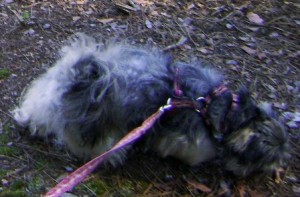Train Dog to Walk on a Leash
Learn how you can get your dog or puppy used to a collar, teach it to walk on a leash, and how to get it to heel without a lot of stress for either of you! Plus, learn some benefits that a daily stroll will do for both of you…
One of the best ways to get some exercise with your dog is to go for a walk. If you take your dog for a walk every day, at least for even 20 minutes, it is a great health benefit for both of you. Plus, yes, it CAN be an enjoyable experience! If you teach your dog when it is still a puppy it is much easier than waiting until later when full grown. I’ll tell you how further on…
Walk Every Day

Walking your dog on a daily basis is a good way to keep it from getting bored.
Bored dogs will do destructive things such as chewing up your furniture, biting, digging holes in your yard.
And, hey, who knows what other creative ideas dogs will think of to pass their time.
What’s a Bored Dog to Do?
Believe me, a bored dog can be very destructive to your defenseless home and furniture. Once your dog thinks nobody is paying any attention to me…I may as well find something fun to do…don’t be surprised if you find your dog munching on your favorite shoes or the corner of the couch or maybe a table leg or two.
When Should You Start Training Your Dog to Walk on a Leash?
You can begin training your dog to walk on a leash already when it is a puppy. In fact, the sooner the better! When it is still a small puppy it is much easier to handle than a full grown dog, especially if it is a large breed of dog.
Once you bring your new puppy home, it is a good idea to also purchase a collar of some sort for it. This way you can begin the training your puppy needs to become a well- behaved dog.
When purchasing a collar for your puppy make sure it is comfortable on him or her. You do not want it to be too tight or too loose either.
A well-fitting collar should allow you to place at least one or two fingers between it and your puppy’s neck.
Train Your Puppy to Wear a Collar
Your puppy may not really like it at first. He or she may try to scratch at it or even try to shake their head to get this thing off! A good thing to do when you first put the collar on your puppy is to give your pup a reward. This will teach him or her that it is good to have a collar on.
If your puppy seems to be having a hard time wearing a collar at first just leave it on for a little while at a time. As your puppy gets more used to the collar, increase the length of time that it is worn. Pretty soon your puppy won’t even seem to notice or care that it is still on many hours later.
Whew! Now that part is accomplished. Puppy does not care whether it has a collar on or not. Now you can go on to the next step and begin to teach puppy to walk on a leash.
How to Teach Puppy to Walk on Leash
Start out slowly at first, just like with the collar. Don’t be thinking you are going to go on a two-mile marathon on your first walk…not unless you want to spend all day at it and possibly end up overwhelming your puppy.
I myself, would suggest just using a lightweight leash, so as not to put a lot of extra weight on the collar. Even with a leash that is lightweight, your puppy is going to notice that there is something dragging on its collar.
Just clip the leash on your puppy’s collar and see what happens. Your puppy may or may not make a big deal about it. Make sure to give your puppy a treat after you do this, so he or she knows this is something good happening. Treats also tend to distract the puppy, so it will not be focused on the leash that is now on its collar.
So, This is How to Teach Your Dog to Walk on a Leash…a Little at a Time!
Let your puppy walk around with the leash attached and keep it slightly slack at first. Although you are not pulling on the leash, your pooch will most likely notice that something is different…and hanging on to its collar.
Try to keep your dog’s attention focused on you as much as possible. This will help so it does not panic when it realizes there is something hanging onto it. Keep up with the treats too!
A good thing to remember is to keep the leash slack or loose..do not go pulling your puppy around with it! You do not want to scare the little pup!
Just leave the leash on for a short time, even a few minutes at a time, depending on your puppy’s reactions. Once you feel your dog is handling this pretty well, keep it on for longer and try putting just a tiny bit of pressure on it.
Teach your Furry Friend to Stay Close
Teaching your dog to stay close to you or heel when going for a walk is a good idea to do when they are a pup, but it still can be done with an older dog too. It just takes some time and patience in either case.
I find by keeping your dog close to you while walking is much safer for everyone. This way you can keep your dog in better control if something unexpected comes up and also you have less chance of getting tripped up in the leash. Often if the leash is left too long the dog can get all tangled up in it too.
Getting Started on Teaching your Dog to Heel
Call your puppy’s name as you add a little pressure on the leash and also show that you have something good for your pup if he or she comes to you. I know, it is bribery…but it works! This will teach the puppy that there is nothing bad about some pressure on its leash.
Otherwise, if you just keep pulling on the leash and drag your puppy around, it is more likely to object to this treatment and pull back, struggle, and put up a fight! This is not a good way for it to learn.
Once your puppy is by your side try walking a few steps and of course, entice them to stay with you with a treat. Call your dog’s name and the word “heel” as you do so and once your dog is alongside you, but a tiny bit behind your heels say “heel” again and give it praise and a treat.
If your pup gets ahead of you, stop and say it’s name. Call it back to you, get its attention! Once it comes back to you, give it praise and try walking forward again while saying it’s name. Make sure to keep your dog’s attention on you while doing so.
Just work at this every day, even for five minutes depending on how well your dog is handling the situation. If your puppy is getting antsy or frustrated it is best not to overdo it. Try again awhile later. Plus, you don’t want to end up frustrated either!
You want your puppy to be happy and enjoy spending time with you, right? Just remember to have patience and think about how you would feel if it was you in your puppy’s place.
On your puppy’s first walk you may not go very far in distance, but it is a learning experience for your puppy, so make sure to keep the treats on hand and only do as much as your puppy seems comfortable with.
Good luck and have fun with your four-legged best friends!
What kind of experiences do you have when you’re walking your dog? Good or bad? Are you having problems walking your dog? What are they?
I’d love to hear from you, whether you have a dog-walking story to tell or questions to ask! So, just go ahead and leave them in the box below!
Go back to home page.
🙂 -Sherry
